Family : Ostraciidae

Text © Giuseppe Mazza

English translation by Mario Beltramini
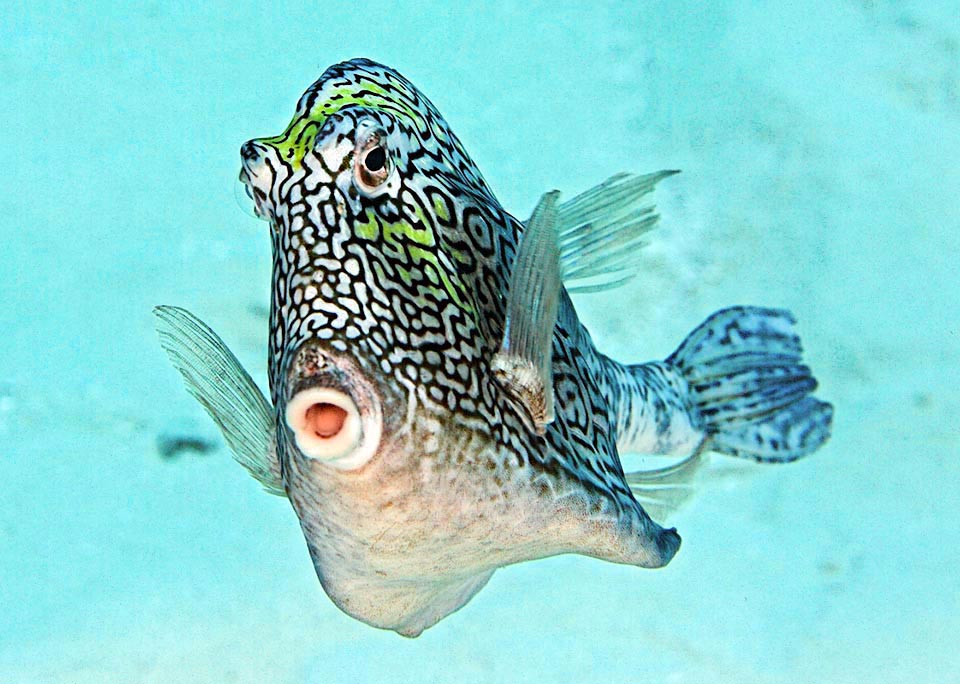
Acanthostracion polygonium is a Caribbean species with very vast range in the western Atlantic, from the Bermuda islands and New Jersey up to Brazil and Uruguay © Allison & Carlos Estape
The Honeycomb cowfish Acanthostracion polygonium (Poey, 1876) belongs to the class of the Actinopterygii, the ray-finned fishes, to the order of the Tetraodontiformes and to the family of the Ostraciidae, the so-called trunkfishes or boxfishes.
An order counting about 350 species united in 10 families. Among the best known, at times present in the aquaria like the unusual Aracanidae, the Balistidae, known as triggerfishes due to their profile and the dorsal trigger, the Diodontidae that groups the pufferfishes, the Molidae with the Ocean sunfish (Mola mola) reserved to the large oceanic aquaria, the Monacanthidae, known as filefishes due to their wrinkled skin once used for smoothing the artefacts and the Tetraodontidae, the most numerous family with 28 genera that guests itself more than 200 species.
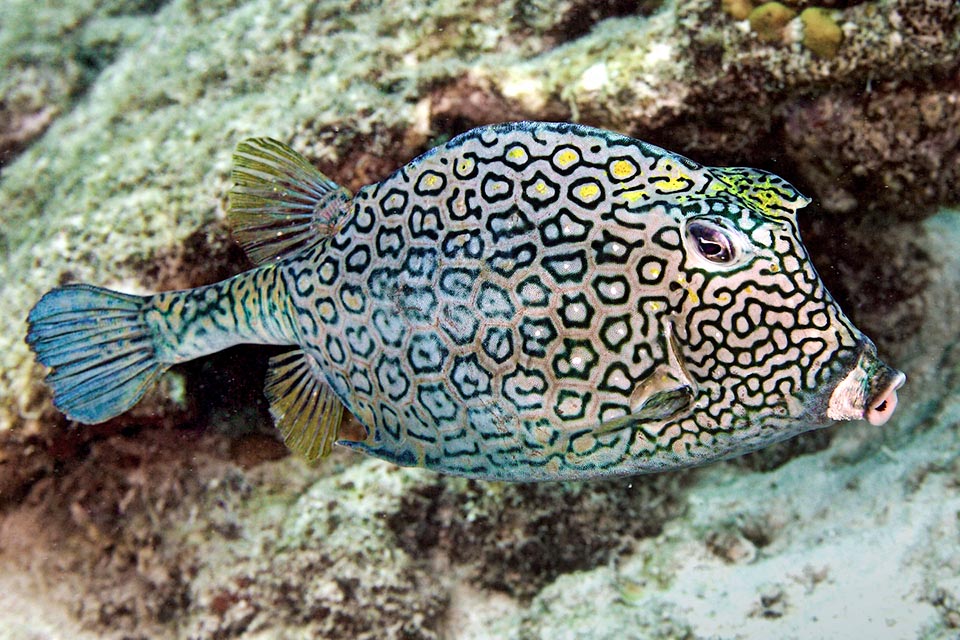
Usually measures 25 cm, but may reach even the length of 50 cm, in fact, more than in aquaria, it often ends up on the table, consumed roasted © Allison & Carlos Estape
The generic term Acanthostracion originates from the Greek “akantha”, spine , and “ostrakon”, shell, with reference to the characteristic underskin protective armour equipped with spines, whilst the specific term polygonium comes from the greek “poly”, many, and “gonius”, corner, evokes the polygonal drawings of its livery.
The strange reference to the cows, present also in its English nickname of “Honeycomb cowfish”, and in the Spanish one of “Torito” or “Torito hexagonal” originates from two spiny protuberances placed on the head like horns, whilst the French, looking at the shape and the livery, call it “Coffre à cornes” of “Poisson-coffre nid d’abeille”.
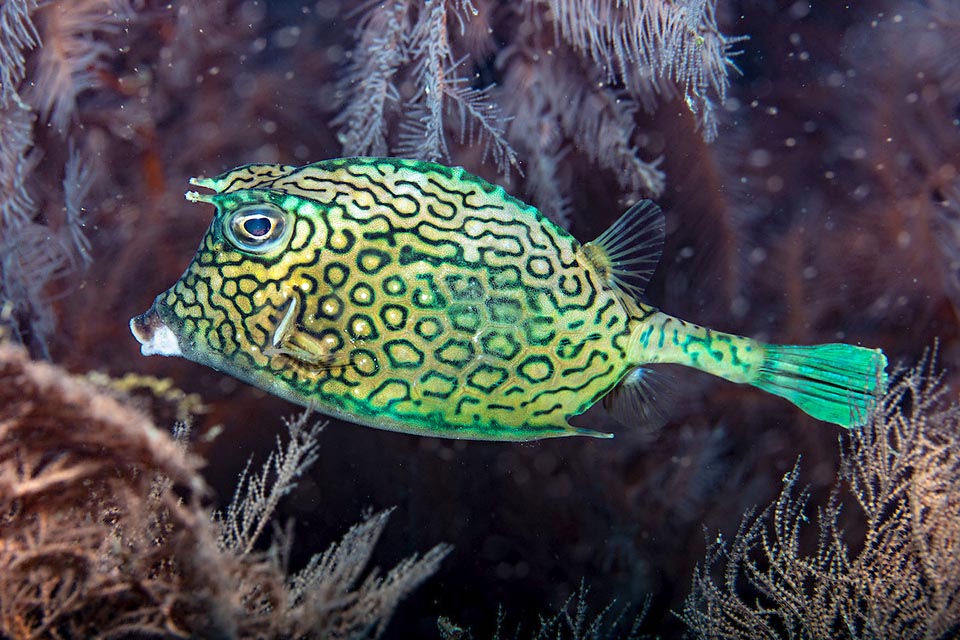
To discourage predators, in addition to the skin poisonous mucus, it has two small horns on the head and two similar just before the anal fin © Allison & Carlos Estape
Zoogeography
Acanthostracion polygonium is a species that has its center in the Caribbean area with a very vast diffusion in the western Atlantic from the Bermuda islands and New Jersey up to Brazil and Uruguay.
Ecology-Habitat
The Honeycomb cowfish lives along the coasts, at 3-80 m of depth, camouflaged between the madreporic formations, but is found also in the submerged prairies and is present in the brackish waters of the estuaries.
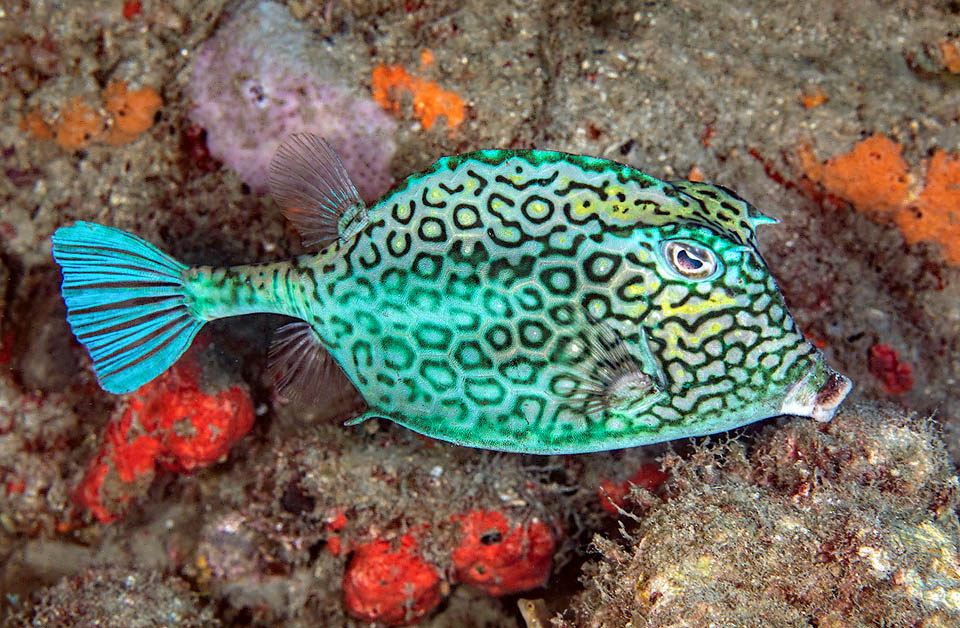
The livery, with polygonal drawings, has blue hues, often instantly grey, green or yellow depending on the mood or for mimetic necessities © Allison & Carlos Estape
Morphophysiology
Usually 25 cm long, with a maximum of 50 cm, Acanthostracion polygonium is an armoured fish, protected under the skin by hexagonal bony merged plates that allow only small openings for the mouth, the nostrils, the gills, the fins and the anus.
The profile is steep with the two characteristic horns close to the eyes, but there are two more of them, no less sharp, facing backwards just before the anal fin, similar in shape and size to the dorsal one.
There are no pelvic fins, the pectoral ones have 12 soft rays and the caudal, rounded, is preceded by a long peduncle.
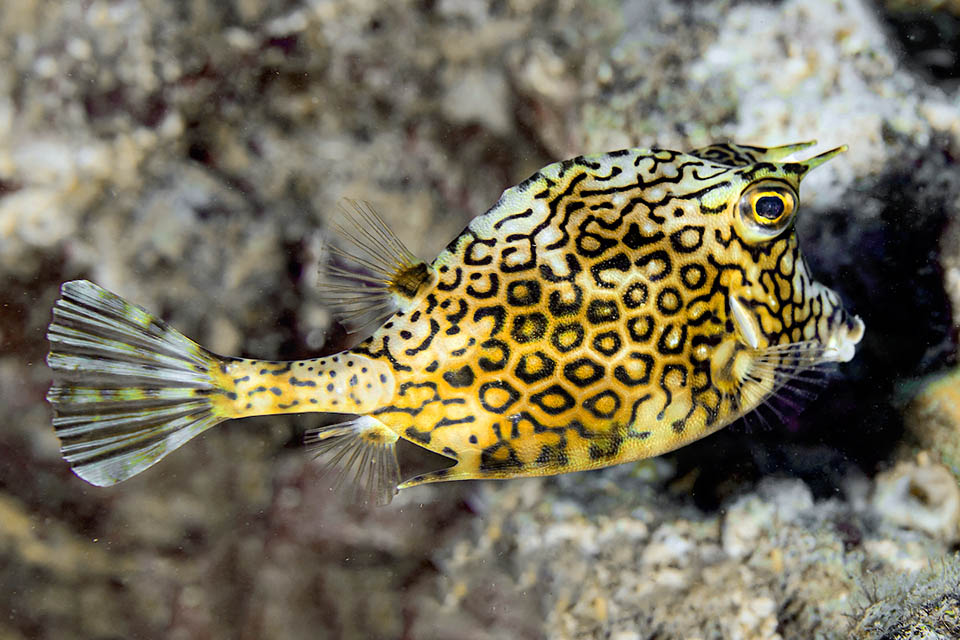
The rounded caudal fin, supported by a long peduncle, is the main motor of the fish helped by the pectoral ones © Allison & Carlos Estape
The locomotion is mainly entrusted to the undulations of the latter assisted by the pectoral ones, whilst the dorsal and teh anal serve as rudder and for accurate manoeuvres.
The small mouth, with fleshy lips, at most has 15 tiny conical teeth per jaw. They serve for catching small benthic invertebrates, chiefly shrimps, or for nibbling sponges, alcyonaria and tunicates.
Apart the honeycomb drawing, sometimes with a small spot at the centre of the hexagons, the skin, protected a poisonous venom, the ostracitoxin, often presents blue shades, that may tend, instantly, to grey, green or yellow due to mimetic necessities or depending on the mood of the fish.
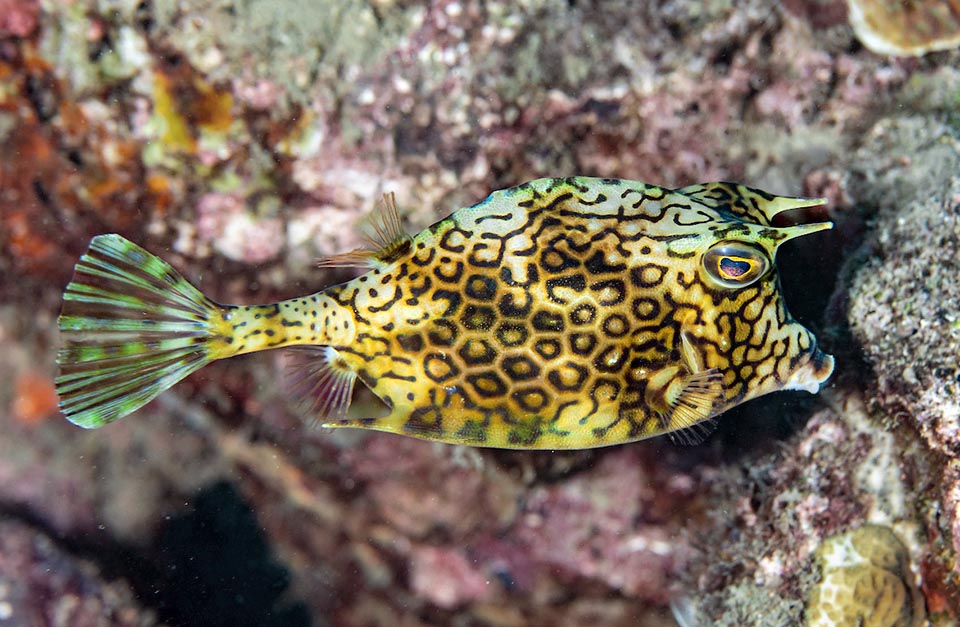
The dorsal and the anal serve as rudders and for careful manoeuvres while preying small benthic invertebrates, chiefly shrimps, or nibbles sponges, alcyonaria and tunicates © Allison & Carlos Estape
Ethology-Reproductive Biology
Acanthostracion polygonium lives usually solitary or in couples.
There is not an evident sexual dimorphism like, for instance, in Ostracion meleagris, but it’s the case also here of a protogynous hermaphroditic species, that is with females that starting from a certain size may turn into males and reign over a small territory where, especially in the reproductive period, allow only the females to enter.
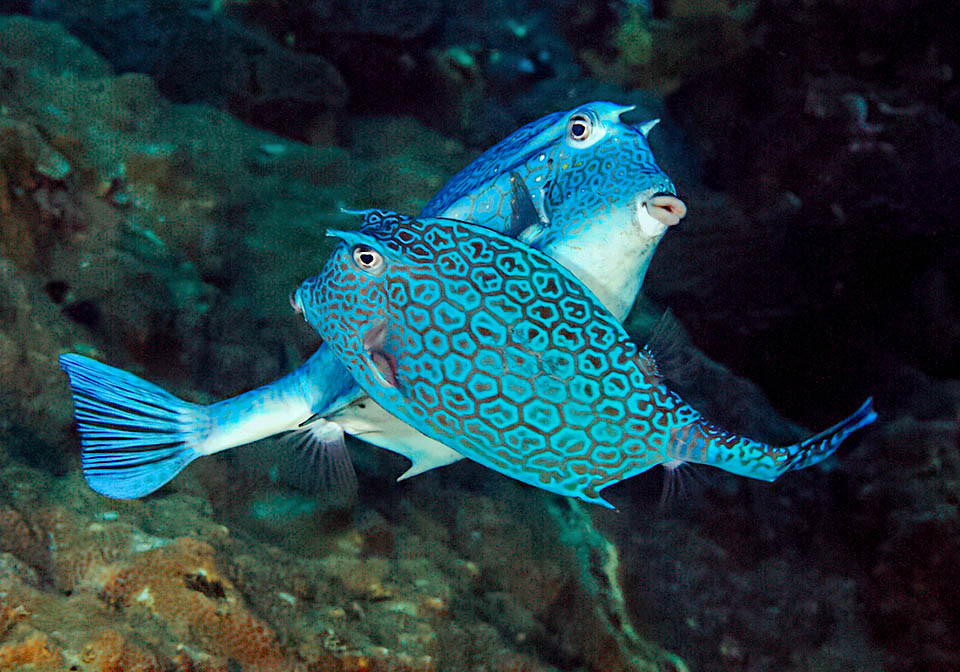
There is no sexual dimorphism. Growing, the females may turn into males with a small territory where during the reproductive period they allow only females to enter © Allison & Carlos Estape
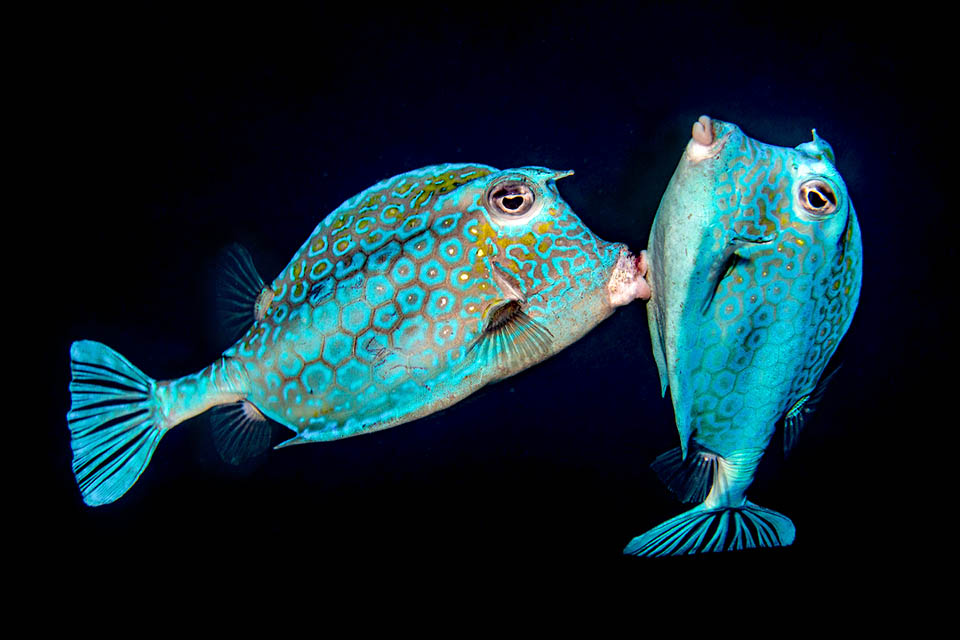
Coupling is preceded by a loving dance with many ups and downs in overlying water column. Ovules and sperm are released at twilight in surface © Allison & Carlos Estape
The fecundation is not collective but occurs in couples. Before ascending to the surface to emit at the same time eggs and sperm, the partners court each other, swimming up and down in the overlying water column.
The deposition usually takes place in the crepuscule, when the eggs, entrusted to the currents, run less risk to be preyed upon. Also the larvae are pelagic, and the few millimetres post larvae present an unusual cubic shape.
When they reach the seabeds also the juveniles, yellow orange with dark red dots, have the appearance of a dice.
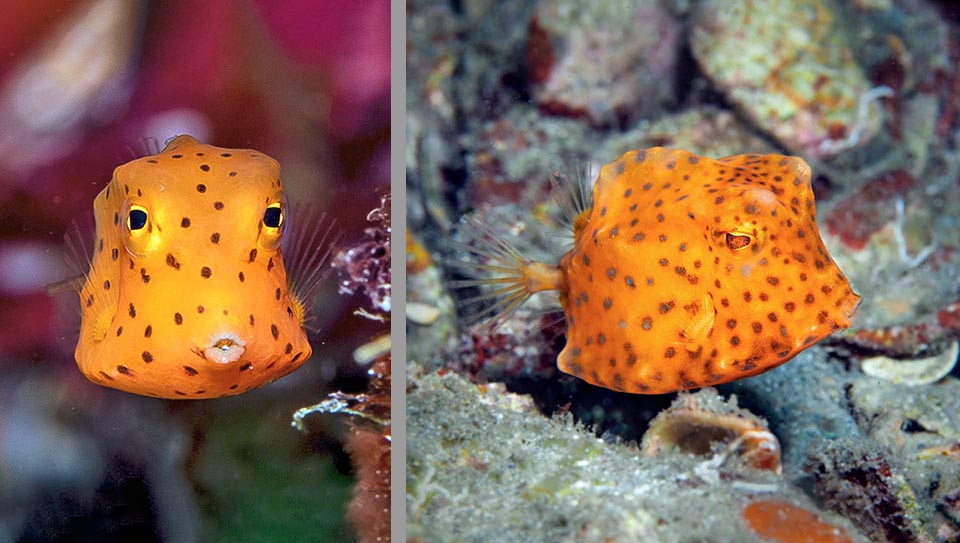
Eggs and larvae are entrusted to currents. The few millimetres post larvae have an unusual cubic shape and when they reach the bottoms also the juvenile forms, with orange yellow livery and dark red spots that get thicker while growing, still have the look of a dice © Allison & Carlos Estape (left) and © Pauline Walsh Jacobson (right)
While growing can be glimpsed the outlines of the horns and then the body elongates and the livery gradually assumes the alveolar drawing of the adults.
Acanthostracion polygonium is fished for the aquaria but when it gets into the nets it often ends up also on the table, cooked roasted. It seems that its flesh is good even if, sometimes, at risk of ciguatera, a serious food poisoning due to the presence of poisonous organisms in their diet.
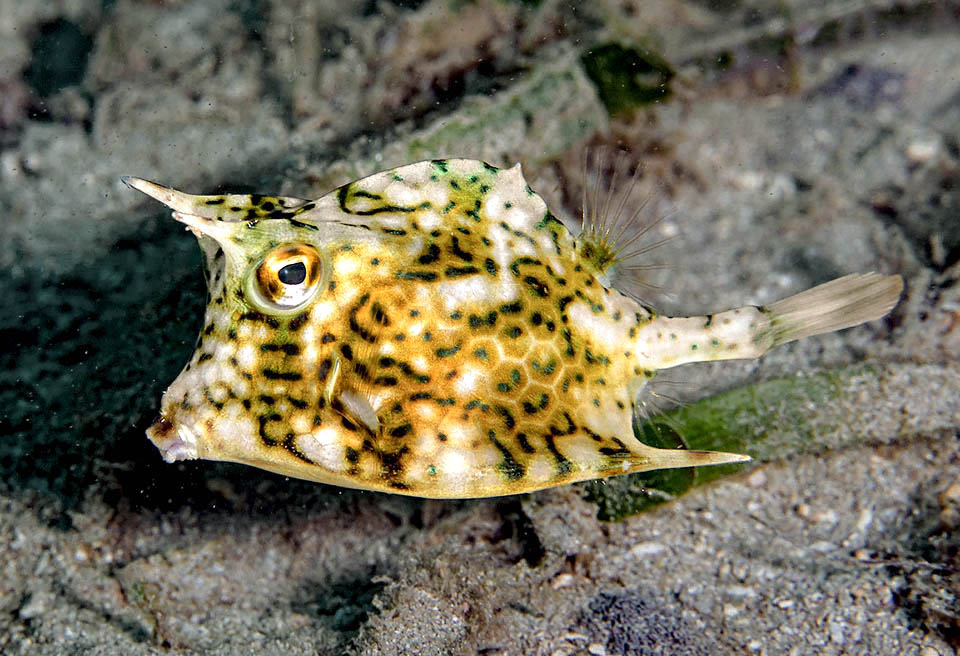
Here a juvenile who has developed the defensive spines and is elongating while, gradually, the alveolate drawing shows up © Allison & Carlos Estape
The resilience of the species is definitely good, with a possible doubling of the populations in less than 15 months, and the fishing vulnerability index, moderate, marks 40 on a scale of 100.
In the IUCN Red List of endangered species it is shown as “Least Concern”.
Synonyms
Acanthostracion polygonius Poey, 1876; Lactophrys polygonia (Poey, 1876); Acanthostracion poligonos Poey, 1876; Acanthostracion polygonia Poey, 1876; Lactophrys polygonius (Poey, 1876); Lactophrys saxatilis Mowbray, 1931.
→ For general information about FISH please click here.
→ For general information about BONY FISH please click here
→ For general information about CARTILAGINOUS FISH please click here.
→ To appreciate the BIODIVERSITY of BONY FISH please click here.
→ To appreciate the BIODIVERSITY of CARTILAGINOUS FISH please click here.
